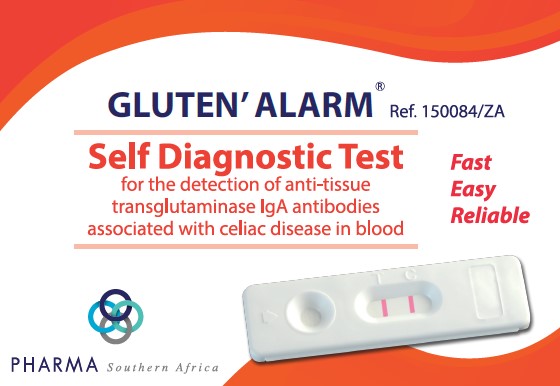
PRODUCT DESCRIPTION
Celiac disease is a long-term autoimmune disorder affecting the small intestine that can occur in genetically predisposed people. It is caused by intolerance to the ingestion of gluten which are various proteins found in wheat, barley and rye. It is estimated to affect 1% people worldwide. Typical symptoms include chronic diarrhea, abdominal pain, gas, weight loss but also anaemia, osteoporosis, extreme fatigue and even delayed growth in case children are affected. Currently, the only treatment for Celiac disease, after being diagnosed, is a strict lifelong gluten-free diet.
Currently, highly effective whole blood tests are the first line screening method to detect the Celiac disease. They are mainly based on the detection of anti-tissue transglutaminase (t-TG) IgA type antibodies.
GLUTEN’ ALARM® by PHARMA Southern Africa is a highly specific immunological rapid test for the detection of anti t-TG IgA type antibodies in finger prick whole blood samples.
Please note this is not a gluten intolerance test.
WHEN SHOULD THE TEST BE PERFORMED?
GLUTEN’ ALARM® should be performed in case of gluten intolerance symptoms or in the case members of the family are already showing this problem. This disease is indeed occurring in genetically predisposed individuals. The test should be performed while being on regular diet (not gluten free diet) to make the result valid.
WHAT DO I HAVE TO DO IF THE RESULT IS POSITIVE?
If the result is positive, it means that anti-t-TG IgA type antibodies are present in blood and that you should consult a doctor to show the test results. Then, the doctor will decide whether additional investigation should be performed.
INCLUDED IN KIT
A sealed aluminum pouch containing:
- 1 test device, 1 plastic pipette and 1 desiccant bag
- 1 sterile lancet for blood sampling
- 1 dropper bottle containing 1 mL of diluent
- 1 instruction leaflet
- 1 alcohol pad
HOW TO USE
Testing procedure always starts with a good preparation. Place the content of the box on a clean, dry and flat surface (e.g. table). Then the testing follows:
- Wash your hands thoroughly. Use soap and warm water. Dry your hand with clean towel.
- Prepare the test device and the pipette. Take them out from the protective pouch (tear at the notch) and place them in the reach of your hands (you will need them later). Discard the desiccant bag.
- Prepare the lancet. Hold the lancet without touching the trigger button. Unlock the lancet cap twisting it off 1⁄4 turn until you feel it separates from the lancet and then continue twisting it (2-3 rotations). Don’t pull just twist and discard the cap when finished.
- Clean the end of the middle finger or ring finger with the alcohol pad. Rub the chosen finger towards the tip for 10 to 15 seconds to enhance the blood flow.
- Press platform firmly against the lateral side of the previously cleaned finger, and press the release trigger button. The tip will automatically retract into the
body of the device. - Rub the finger’s end to obtain enough whole blood sample.
- Without pressing the bulb, put in contact the plastic pipette with the blood sample. The blood migrates into the pipette through capillarity to the line indicated on the pipette. You may rub again your finger to obtain more blood if the line is not reached. As far as possible, avoid air bubbles.
- Put the blood collected with the pipette into the sample well of the device, by pressing on the pipette bulb.
- Wait 30-40 sec for the blood being totally absorbed into the sample well. Unscrew the blue cap of the diluent dropper bottle (leave the white cap tightly screwed) and add the diluent as follows: Hold the diluent dropper bottle vertically and slowly add exactly 4 drops in the sample well of the device with an interval of 2-3 seconds between each drop.
- Read the result after 15 minutes. Do not interpret after 20 minutes.
Click here to view the patient information leaflet.


